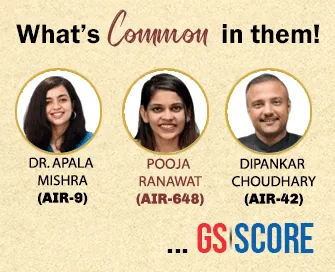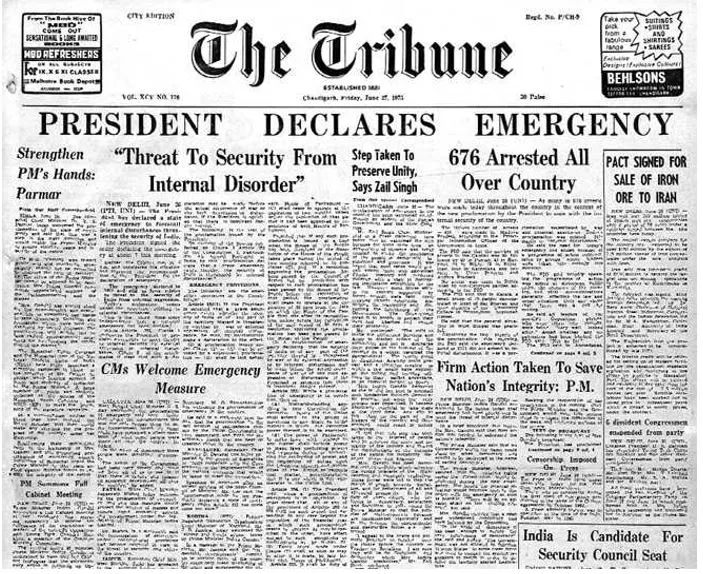

26th June 2025 (28 Topics)
Context
June 25, 2025 marks the 50th anniversary of the Emergency declared in 1975 — a 21-month period when civil liberties were suspended, the Constitution was altered to expand central power, the media was censored, and mass detentions took place.
Background: What led to the Emergency?
The Emergency was declared in the context of rising political opposition, economic crisis, and a court ruling disqualifying the sitting Prime Minister.
- Economic crisis: India was facing high inflation, unemployment, and food shortages post the 1971 war with Pakistan, global oil crisis (1973), and internal governance failures.
- Political opposition: A powerful opposition movement emerged, led by Jayaprakash Narayan (JP), who called for “Total Revolution (Sampoorna Kranti)” to fight corruption and authoritarianism.
- Court ruling: On June 12, 1975, the Allahabad High Court found Prime Minister Indira Gandhi guilty of electoral malpractice under the Representation of the People Act, 1951, and disqualified her from office for six years.
- The Supreme Court gave a conditional stay, allowing her to remain PM but not vote in Parliament.
- As public protests intensified, Indira Gandhi advised the President to declare a national Emergency.
Constitutional Basis of the Emergency
- On June 25, 1975, President Fakhruddin Ali Ahmed declared an Emergency under Article 352 of the Constitution, citing “internal disturbance” as the reason.
- This was the first peacetime Emergency (previous ones were during wars in 1962 and 1971).
- Article 352 (before 44th Amendment) allowed Emergency to be declared on grounds of war, external aggression, or internal disturbance.
Important Note: The term “internal disturbance” was later replaced with “armed rebellion” in 1978 through the 44th Constitutional Amendment to prevent misuse.
Major Legal and Constitutional Consequences
- Suspension of Fundamental Rights
- Article 358: Automatically suspended Article 19 (freedom of speech, movement, etc.).
- Article 359: Allowed the government to suspend enforcement of rights like equality before law (Art. 14), protection of life and liberty (Art. 21), and protections against arbitrary detention (Art. 22).
- Citizens could not approach courts for redress.
- Preventive Detentions and Arrests: Over 1.1 lakh people were detained, including almost all opposition leaders (JP, Morarji Desai, Vajpayee, Advani). MISA (Maintenance of Internal Security Act) and COFEPOSA were used for arrests without trial.
Constitutional Amendments Passed During Emergency
|
- ADM Jabalpur Case (1976): The Supreme Court ruled that even the right to life could be suspended during Emergency. Only Justice H.R. Khanna dissented, famously stating that life and liberty cannot depend on the mercy of the executive.
- Media Censorship and Control
- Pre-censorship was imposed: newspapers had to submit content to government censors.
- Power to newspaper offices was cut in Delhi.
- News agencies were merged into one: Samachar.
- The Press Council of India was abolished.
- Journalists like Kuldip Nayar were jailed.
- Some newspapers resisted — The Indian Express famously left editorial columns blank in protest.
- Forced Sterilisation Campaign: Promoted as part of population control by Sanjay Gandhi (Indira's son). Over 1.07 crore sterilisations done in two years.
End of the Emergency and Aftermath
- Emergency was lifted on March 21, 1977. In the 1977 General Elections, Indira Gandhi’s Congress was defeated.
- The Janata Party, a coalition of opposition forces, came to power.
- Morarji Desai became the first non-Congress Prime Minister.
Post-Emergency Reforms
- 44th Constitutional Amendment (1978) replaced “internal disturbance” with “armed rebellion” in Article 352. It restored judicial review of Emergency proclamations. It made it mandatory for Emergency to be approved by both Houses of Parliament by a special majority within one month. Also, it strengthened protection for Article 20 and 21, even during Emergency.
- Shah Commission of Inquiry (1977–79): Headed by Justice J.C. Shah, it investigated abuses during the Emergency.
- Findings:
- Mass illegal detentions under MISA.
- Media censorship and intimidation.
- Forced retirements of 25,962 public employees.
- Over 1 crore forced sterilisations; 1,774 linked deaths and many abuses.
Enduring Legacy for Indian Democracy
- The Emergency exposed the vulnerabilities of India’s constitutional setup.
- It showed how institutions (judiciary, media, bureaucracy) can bend under political pressure.
- However, it also demonstrated the resilience of democracy — public backlash led to the defeat of an authoritarian regime through peaceful elections.
- It birthed a generation of opposition leaders (like Lalu Yadav, Ram Vilas Paswan, George Fernandes, Jaitley) and institutional reforms.
Landmark Cases: Judicial Interpretation of Emergency Provisions
|
Conclusion
The 1975–77 Emergency remains a powerful lesson in how democratic safeguards must be preserved at all costs. It reshaped India's constitutional architecture, enhanced checks on executive power, and serves as a reminder that liberty, once lost, is not easily regained.



